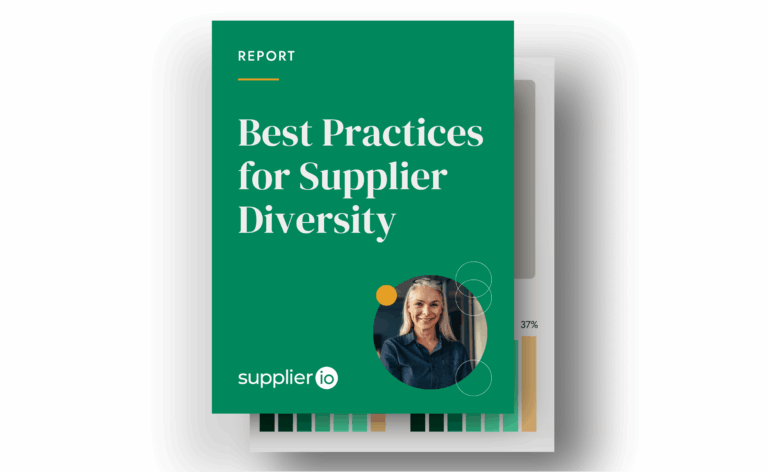4 Guidelines for Supplier Diversity in 2024
Supplier diversity programs have a lot of opportunity in 2024. But are you ready? Check out these trends to set your supplier diversity and responsible sourcing program up for success in the coming year.

Supplier diversity programs experienced many successes and challenges in 2023. While program growth was met with obstacles from the economy and politics, the industry’s continued focus on data and systems had an extremely positive impact.
But what will 2024 look like for supplier diversity programs globally? We’ve surveyed the industry, looked at the data, and spoken with our customers. Here are three trends you can look out for in the year ahead.
Continued improvements to data and systems
Supplier diversity drove huge improvements in data and systems in 2023. An important truth became apparent: The quality of your supplier diversity program is only as good as the data and metrics you use to measure growth.
When supplier diversity leaders were asked about the biggest improvements to their programs in 2023, their top two responses were related to data and systems integration. In fact, tracking and reporting metrics was the top priority of supplier diversity leaders, with 67% reporting that they’re now relying on third-party data providers to ensure accuracy.
This is now the number one tool leaders turn to, up from number three in 2022. We expect to see a continued focus on data and systems integration, especially as more leaders infuse supplier diversity into the fabric of procurement and how the company operates.
There’s also a strong relationship between supplier diversity leaders and their ESG counterparts that we expect to continue next year. Last year, some leaders saw ESG programs as possible competition that might pull valuable resources away from diversity programs. As it turns out, supplier diversity leaders now see their ESG counterparts as a positive partner (55%). On top of that, 38% of leaders are now responsible for reporting on both supplier diversity and sustainability.
Expect this trend to continue as both programs require accurate data and supply chain transparency.
Going beyond spend metrics
With more emphasis on systems integration and accurate data, supplier diversity metrics and reporting are evolving. Today, 86% of organizations use “dollars spent with diverse suppliers” and 80% use “spend with diverse suppliers as a percent of total spend” to measure the success of their program.
But overall spend data only tells a portion of that story. Metrics and measures will continue to evolve as supplier diversity becomes fused with the business and included in more ESG reports. Some simple improvements might include tracking the number of diverse suppliers beyond just the spend.
For example, leaders today measure supplier diversity spend down to the business unit and location level. Some go a step further and measure the actual economic impact of their program on the communities they serve including jobs, wages, taxes and more. Sixteen percent of organizations plan to be more public about their supplier diversity programs, understanding the potential impact it can have on their brands, sales, and hiring.
Leading supplier diversity programs are looking into more ways they can measure this impact by partnering with their marketing counterparts on NPS (Net Promoter Score) surveys, as well as tracking RFP wins that include supplier diversity.
Going beyond supplier diversity
In 2022 many supplier diversity leaders were concerned that increased focus on growing environmental regulations would shift attention away from their programs to support ESG and sustainability initiatives. That didn’t seem to be the case. In fact, 55% of supplier diversity leaders said that the company’s ESG initiative helped their supplier diversity program. Even more revealing was that 38% said they are now responsible for reporting both social and sustainable spend in the supply chain. This makes a lot of sense, and we expect to see more leaders take on this type of reporting. It’s intuitive really. Many companies know their biggest environmental impact is in their supply chain with Scope 3 Green House Gas emissions. Procurement can continue to add value and provide greater visibility into the supply chain with accurate and detailed supplier data across environmental, social, and governance aspects.
Making supplier diversity work outside the US
Supplier diversity isn’t just a US priority. The Hackett Group’s 2022 global survey found that almost every major company in the UK has a supplier diversity program, with Germany, France, Ireland, South Africa, Australia, and many others right behind. Even US-based global companies are expanding their programs to other countries while they adapt to local business conditions.
The UK could see a model similar to the US with strong certification agencies like MSDUK. But in other countries we’re seeing an evolving model: Companies are willing to accept more self-certification, shifting their strategy from focusing on their internal needs to surveying the local market of diverse suppliers. Why? To identify their biggest growth opportunities before category planning.
This country- and region-specific approach has massive opportunities as organizations grow and local suppliers can report their business offerings.
Going forward
While politics and the economy may not have improved supplier diversity programs in 2023, leaders will continue to make strides. In 2024, expect to see better data, more insightful reporting, deeper integrations with ESG initiatives, and global expansion.
Want to learn more? Download the Supplier Diversity Top 5 Best Practices for 2024 report to gain actionable insights from the top-performing supplier diversity programs.




